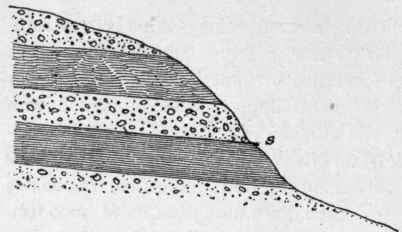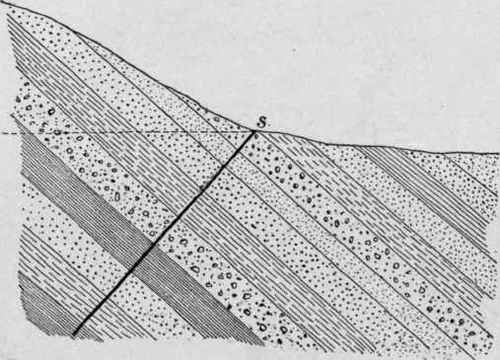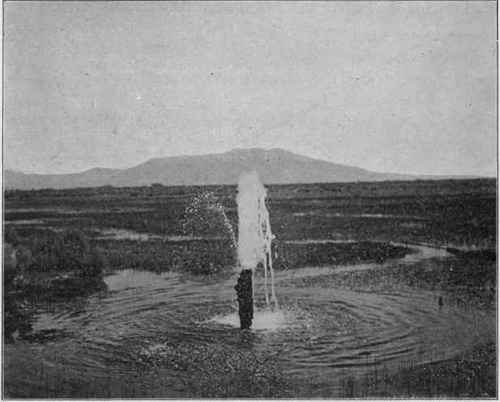2. Springs
Description
This section is from the book "An Introduction To Geology", by William B. Scott. Also available from Amazon: An Introduction to Geology.
2. Springs
Springs are the openings of the ground water upon the surface, and could not be formed were the land perfectly free from irregularities, for gravity controls the movement of underground waters, and the source of a spring must be higher than its mouth. It must be remembered, however, that a subterranean stream is often confined as in a pipe, and that the pressure to which it is subjected may seem to make it flow upward, as when a spring rises from a deep fissure, or bursts out upon the top of a hill. But these are not real exceptions, and here also the source, which may be many miles distant, is above the spring, and it is this which produces the necessary pressure.
The commonest type of spring is formed when a relatively impervious bed of rock (usually clay in some form) overlaid by porous rocks, crops out on a hillside. The ground water saturates the lower layers of the porous beds, until its descent is arrested by the impervious bed, and then the water follows the upper surface of the latter. When, by some irregularity of the ground, the impervious bed comes to the surface, the water will issue as a spring, or a line of springs (see Fig. 51) A second class of springs are those which rise through a crack or fissure in the rocks. Inclined porous beds, enclosed between more impervious ones, allow the water to follow them downward, until in its lower course such water is under great pressure, or "head" (Fig. 52). On reaching a fissure opening upward, the water will rise through it and, if under sufficient pressure, will come to the surface.
An artesian well is an "artificial fissure-spring." It is a boring which taps a sheet or stream of the ground water, when the water is under sufficient pressure to rise to the surface or even spout high above it.
In limestone districts depressions of the surface may intersect the course of considerable underground streams, which thus reach the surface in springs of unusual volume. Very striking and beautiful examples are the Giant Spring in the canon of the upper Missouri, near Great Falls, Montana, and Silver Spring, Florida, which is navigable for steamboats.
Springs, as such, do little in the way of rock disintegration, but they accomplish something by undermining the rocks at the point where they issue, and thus working their way backward. This process is known as the recession of spring-heads. The underground streams, of which springs are the outlets, have often effected much in the way of dissolving rock material, and hence spring-water always contains dissolved minerals, principally the carbonates and sulphates of lime and magnesia, and the chlorides of magnesium and sodium. In mineral springs the quantity of dissolved materials is larger and perceptible to the taste.

Fig. 51. - Arrangement of strata which causes hillside springs. The lower close-lined bed impervious.
Thermal Springs are those whose temperature is notably higher than that of ordinary springs in the same region, and they range from a lukewarm to a boiling state. This increase of temperature may be caused in either of two ways: (1) In volcanic regions, water coming into contact with uncooled masses of lava is highly heated and reaches the surface as a hot spring. Of this class are the innumerable thermal springs of the Yellowstone Park. (2) Wherever the disposition of the rocks is such that water may descend to great depths within the earth and yet return to the surface by hydrostatic pressure, thermal springs appear. These conditions are found only in regions where the rocks have been much folded and fractured. In this case the temperature of the water is raised by the interior heat of the earth, which, as we have seen, increases with the depth. Springs of this class occur numerously along the Appalachian Mountains, and in larger numbers and of higher temperatures they accompany the various ranges of the Rocky Mountains and Sierra Nevada.

Fig. 52. - Diagram of fissure-spring. The heavy line represents the fissure along which the water rises.
Geysers are thermal springs which periodically erupt, throwing up hot water in beautiful fountains, accompanied by clouds of steam. Though of great scientific interest, geysers are not important geological agents, because of their rarity, since they occur only in Iceland, the Yellowstone Park, and New Zealand.

Fig. 53. - An artesian well. (U. S. G. S).
The destructive effects of thermal springs are principally accomplished below the surface, and have already been considered under the head of underground waters. The high percentages of dissolved materials which such springs usually contain are evidence of the important work of rock disintegration which they perform.
Continue to:


